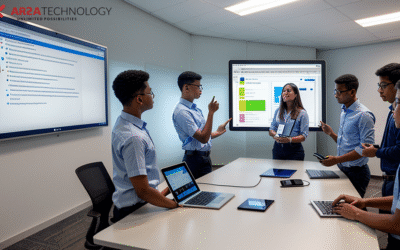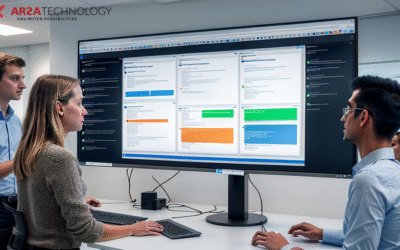Introduction: Overcoming Identity Fraud in Government Social Programs
Government social programs are vital safety nets, providing essential support to millions. However, these critical initiatives are increasingly targeted by sophisticated identity fraud schemes, leading to significant financial losses, erosion of public trust, and delays in delivering aid to legitimate beneficiaries. The challenge for government agencies lies in implementing robust, efficient, and scalable identity verification processes that can withstand evolving fraud tactics while maintaining accessibility for all citizens. This is where advanced biometric solutions, specifically a powerful face recognition API, become indispensable.
ARSA Technology understands the unique demands of the public sector. Our Face Recognition API is engineered to provide a comprehensive and reliable solution for Automated Know Your Customer (KYC) verification, directly addressing the core pain point of identity fraud in social programs. This guide is designed for software developers, solutions architects, CTOs, and product managers within government agencies who are seeking to integrate cutting-edge biometric technology to secure their services, streamline operations, and restore confidence in public assistance.
The Pervasive Threat: Identity Fraud’s Impact on Public Services
Identity fraud in government programs manifests in various forms, from individuals attempting to claim benefits under false pretenses to organized criminal networks exploiting systemic vulnerabilities. The consequences are far-reaching:
* Financial Drain: Billions of dollars are lost annually to fraudulent claims, diverting funds from those who genuinely need them.
* Erosion of Trust: When fraud goes unchecked, public confidence in government’s ability to manage resources and deliver services responsibly diminishes.
* Operational Burden: Manual verification processes are slow, resource-intensive, and prone to human error, creating bottlenecks and increasing administrative costs.
* Delayed Aid: Legitimate applicants often face prolonged waiting periods due to the need for thorough, yet often inefficient, fraud checks.
Traditional verification methods, such as document checks and manual data entry, are no longer sufficient to combat the scale and sophistication of modern identity theft. A shift towards automated, secure, and highly accurate verification is not just an upgrade; it’s a necessity for the integrity and efficacy of public services.
Automated KYC: A Paradigm Shift for Government Verification
Automated KYC leverages technology to verify an individual’s identity quickly and accurately, often without the need for in-person interactions. For government social programs, this means:
* Enhanced Security: Robust checks reduce the likelihood of fraudulent applications.
* Increased Efficiency: Faster processing times mean quicker access to benefits for eligible citizens.
* Reduced Costs: Automation minimizes the need for manual review, freeing up valuable human resources.
* Improved Citizen Experience: A seamless, digital verification process is more convenient and accessible.
ARSA Technology’s Face Recognition API is a cornerstone of such an Automated KYC framework. It enables agencies to confirm an applicant’s identity by comparing their facial biometrics against official records, ensuring that the person applying is indeed who they claim to be. This capability is crucial for programs ranging from unemployment benefits and housing assistance to healthcare subsidies and pension disbursements.
ARSA’s Face Recognition API: Precision and Reliability for Public Sector Needs
At its core, ARSA’s Face Recognition API provides a powerful, cloud-based solution for accurate and rapid facial identity verification. It is designed with the rigorous demands of government applications in mind, prioritizing security, accuracy, and ease of integration.
The API functions by analyzing unique facial features from an image or video input and comparing them against a known database or another provided image. This comparison yields a confidence score, indicating the likelihood of a match. This process is fundamental for:
* One-to-One Verification: Confirming that a person’s live image matches their photo on a government ID or existing database record.
* One-to-Many Identification: Searching for a person’s face within a larger dataset of enrolled individuals (with appropriate legal and ethical safeguards).
To see the API in action and understand its capabilities firsthand, try our interactive demo on RapidAPI. This playground allows developers to experiment with the API’s core functions in a controlled environment, demonstrating its ability to process facial data and return verification results swiftly.
Key Benefits for Government Agencies and Developers
Integrating ARSA’s Face Recognition API into government systems offers a multitude of advantages, directly addressing the challenges of identity fraud and operational inefficiency:
1. Unmatched Accuracy in Identity Verification:
The API employs advanced algorithms to ensure high precision, minimizing false positives and false negatives. This accuracy is paramount in government contexts where incorrect verification can have significant consequences for citizens and public funds. By providing secure identity verification solutions, ARSA helps agencies make informed decisions with confidence.
2. Streamlined Onboarding and Application Processes:
Automated facial recognition significantly reduces the time and effort required for identity checks during application submissions. Citizens can complete verification remotely, reducing the need for in-person visits and accelerating access to vital services. This efficiency translates into a better experience for citizens and reduced administrative burden for agencies.
3. Robust Fraud Prevention:
By verifying the identity of applicants against official records, the API acts as a powerful deterrent against identity theft and fraudulent claims. When combined with complementary technologies like liveness detection (for preventing fraud with liveness detection), the system becomes even more resilient against sophisticated spoofing attempts.
4. Scalability and Reliability for Large-Scale Programs:
Government social programs often serve millions of individuals, requiring a verification system that can handle immense volumes of transactions without compromising performance. ARSA’s API is built on a high-performance infrastructure, ensuring reliability and scalability to meet the demands of national and regional programs.
5. Enhanced Compliance and Auditability:
Implementing a standardized biometric verification process helps agencies adhere to regulatory requirements for identity management and data security. The API provides clear, auditable records of verification attempts, which is crucial for accountability and compliance reporting.
6. Developer-Friendly Integration:
ARSA Technology designs its APIs for seamless integration into existing government IT infrastructures. Developers can quickly incorporate facial recognition capabilities into web portals, mobile applications, and backend systems, accelerating deployment and reducing development cycles. Our comprehensive documentation and support ensure a smooth integration experience.
Building a Secure Future: Practical Applications and Considerations
For developers and architects, leveraging ARSA’s Face Recognition API means more than just adding a feature; it means building a more secure, efficient, and citizen-centric public service ecosystem. Consider these practical applications:
- Online Benefit Applications: Integrate facial verification into online forms to confirm the identity of applicants for unemployment, housing, or food assistance programs.
- Digital Citizen IDs: Develop secure digital identity platforms that use facial biometrics for authentication, enabling citizens to access various government services with a single, verified digital ID.
- Remote Notarization and Witnessing: Facilitate secure remote processes that require identity confirmation, such as signing official documents or witnessing declarations.
- Access Control for Sensitive Data: Enhance security for government employees accessing confidential information by implementing facial recognition as a multi-factor authentication method.
When planning an integration, developers should consider data privacy and security protocols. ARSA Technology is committed to robust data handling practices, ensuring that sensitive biometric data is processed securely and in compliance with global privacy standards. The API focuses on providing verification results, not storing extensive biometric databases, giving agencies control over their data.
Conclusion: Your Next Step Towards a Solution
The fight against identity fraud in government social programs requires advanced, reliable, and scalable solutions. ARSA Technology’s Face Recognition API offers a powerful tool for developers and agencies to implement robust Automated KYC verification, securing vital public services and fostering greater trust among citizens. By integrating this cutting-edge biometric technology, government entities can significantly reduce fraud, enhance operational efficiency, and deliver aid more effectively to those who need it most.
We invite you to explore the capabilities of ARSA’s Face Recognition API and discover how it can transform your agency’s identity verification processes.
Ready to Solve Your Challenges with AI?
Discover how ARSA Technology can help you overcome your toughest business challenges. Get in touch with our team for a personalized demo and a free API trial.







